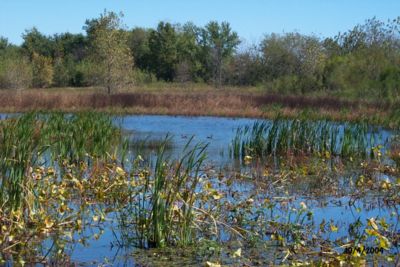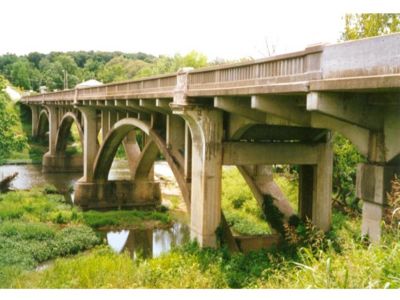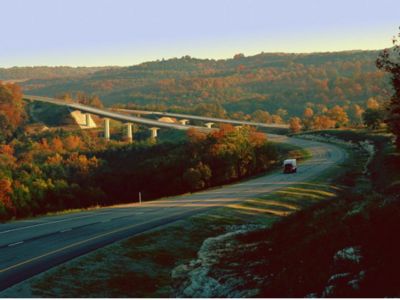Category:127 MoDOT and the Environment
| Environmentally Friendly MoDOT |
Missouri is commonly known as the “Show-Me State” but another apt and well-used nickname is “Sportsman’s Paradise.” The latter refers both to Missouri’s abundant fish and game resources and to the excellent environment in which these natural resources thrive. The Missouri Department of Transportation (MoDOT) is responsible for constructing and maintaining the state’s transportation system within the framework of Missouri’s outstanding natural and cultural resources as well as its rural and urban communities.
| MODOT is a Good Steward of Missouri's Natural and Cultural Rescources |
| Find out why MoDOT performs environmental studies and historic preservation. |
In 1969, the U.S. Congress passed the National Environmental Policy Act (NEPA) in response to increasing concern about the environment. This act requires assessing environmental impacts for all major federal actions, including all federally funded and/or federally permitted highway and transportation projects that the Federal Highway Administration (FHWA) and other federal transportation agencies administer. Although MoDOT is especially concerned with projects that significantly affect the human environment, we must also consider
whatever impacts a project will have on all our state’s resources. Missouri has been a national conservation leader since the 1930s, when the Conservation Federation of Missouri and the Missouri Department of Conservation were organized. Our large state parks system, managed by the Missouri Department of Natural Resources, includes both natural resources and historic sites and is recognized as one of the five best systems in the nation.
Like other Missourians, many MoDOT employees enjoy hunting, fishing, or another of the state’s numerous outdoor opportunities. MoDOT’s transportation efforts must be sensitive to the Missouri environment that we all encounter and enjoy. It is, after all, our own environment and that of our families, friends, neighbors, pets, livestock, and fish and game. We seek transportation solutions that fit into their surroundings with minimal impacts.
To satisfy the requirements of NEPA, MoDOT must evaluate the impacts a transportation project will have on the natural and human environment and document these impacts in one of three ways:
| Environmental Impact Statement (EIS) |
| Environmental Assessment (EA) |
| Categorical Exclusion (CE) |
MoDOT is responsible for preparing appropriate documentation to enable the expenditure of federal dollars and the issuance of federal permits for Missouri’s proposed transportation projects. Design's Environmental and Historic Preservation Section has staff specializing in the areas of historic preservation and cultural resources (i.e., archaeology, structures and bridges), community impact, wetland, streams and water quality, social and economic concerns, threatened and endangered species/wildlife/habitat, hazardous and solid waste, floodplains/parklands/agriculture(i.e., farmland conversion)/land use, and air quality and noise. These specialists analyze the impacts that transportation projects will have, with the level of analysis dependent on the scope of the project and its impacts as well as the type of environmental documents being prepared.
| Topics MoDOT considers in planning, project development, construction, and maintenance of Missouri's transportation system | |
| Air quality | Noise |
| Wetlands | Water quality/Stormwater |
| Social and economic impacts to the human environment | Floodplains |
| Endangered species and wildlife habitat | Farmland |
| Historic and archaeological sites | Solid and hazardous waste |
| Publicly owned parks, recreation areas, and wildlife and waterfowl refuges | |
| Roadside Inventory, Environmental |
| Report 2005 |
| Report 2004 |
| Water Quality |
| Developing a Water Quality Monitoring System Framework |
| Alternative Energy |
| Alternative Energy Resources for MoDOT |
| See also: Research Publications |
The NEPA process concludes with designation of a CE, completion of a Final EIS and its Record of Decision (ROD), or completion of a Finding of No Significant Impact (FONSI) for an EA. Although the NEPA process preferably serves as an umbrella to cover other environmental regulations (e.g., the National Historic Preservation Act, the Clean Water Act, Section 4(f), etc.), those additional, separate regulations must all be fully addressed before final project design can be confirmed, right of way can be acquired, and construction can proceed. Completing the NEPA requirements does not guarantee that those other separate environmental regulations have been satisfied.
The links in this introduction offer detailed information concerning specific requirements with which MoDOT must comply, the process and steps involved in investigating impacts, and the information needed from MoDOT districts and divisions to facilitate the analysis and documentation of environmental impacts expected from proposed transportation projects.
Articles in "127 MoDOT and the Environment"
The following 27 pages are in this category, out of 27 total.
1
- 127.1 Request for Environmental Services
- 127.2 Historic Preservation and Cultural Resources
- 127.3 Community Impact Assessment
- 127.4 Wetlands and Streams
- 127.7 Threatened and Endangered Species
- 127.8 Hazardous and Solid Waste
- 127.9 Floodplain Management
- 127.10 Section 4(f) Public Lands
- 127.11 Farmland Conversion
- 127.12 Air Quality
- 127.13 Noise
- 127.14 National Environmental Policy Act (NEPA) Classification and Documents
- 127.15 Reevaluation of National Environmental Policy Act (NEPA) Documents
- 127.16 Wetland and Stream Mitigation
- 127.17 Wetland and Stream Mitigation Banking
- 127.18 Job Special Provisions (JSP) and Contract Documents
- 127.19 Section 404 Clean Water Act for Bridge Demolitions
- 127.20 Stream Stewardship Trust Fund in-Lieu Fee Mitigation Program
- 127.21 Federal Emergency Management Agency (FEMA) Flood Buyout Properties
- 127.22 Off-Site Borrow, Spoil, and Staging Areas
- 127.23 Negotiated Commitments and Mitigation in the National Environmental Policy Act (NEPA) Process
- 127.24 Speleological Findings
- 127.25 Maintenance Environmental Policies
- 127.26 Environmental Classification
- 127.27 Guidelines for Obtaining Environmental Clearance for Off-Site Activities
- 127.28 Planning and Environmental Linkages (PEL) and the National Environmental Policy Act (NEPA)
- 127.29 Stormwater


